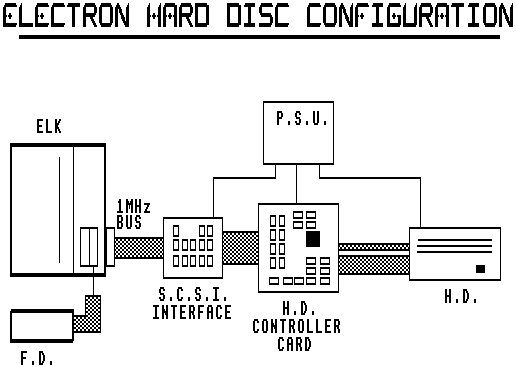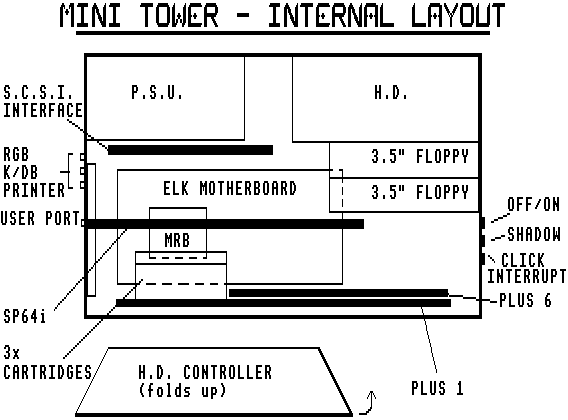Introduction
MEGA BYTES ON A KILO BYTE MACHINE
By Derek Walker
MY project for this summer was to attach a Winchester Drive (Hard Disk (HD)) to my Electron.
Over the last year or so I have been collecting the hardware and software required and a
couple of weeks ago I found the last piece in the jigsaw.
The major components involved in the project were:
The Hard Disk Drive - I used a Maxtor 15 head/1023 cylinder drive with a ST506 interface.
The format used by ADFS is that each cylinder has 32 sectors each containing 256 bytes:
256 x 32 x 1023 x 15 = 125,706,240 bytes.
The Hard Disk Controller - I used a OMT5200 controller. This card carries out all the
disk housekeeping and has two interfaces - a SCSI (Small Computer Systems Interface -
pronounced skuzzy) and a ST412/506 interface. The block diagram shows how everything
is linked together.
The Host Adaptor - This part I had to build myself. I had obtained a copy of the Acorn
Host Adaptor circuit diagram and had started to build the circuit on Vero board but it
turned out to great a task. I eventually contacted a member of a BBC user group who
helped me obtain a circuit board, this made life a lot easier.
The 1MHz bus - I used the low cost bus from PRES, this had to be modified by removing
the data buffer chip and wiring through the NPGFC signal from the cartridge slot connector
to the 1Mhz bus connector.
Pres Plus 3 ADFS - I have PRES's Plus 3 cartridge disk interface which uses their own
version of Acorn's ADFS - v1.10, this software doesn't have the necessary patches to
talk to the HD so I had to obtain a copy of Acorns original Electron ADFS ROM v1.0.
The ADFS ROM has to be fitted to the highest priority socket available.
Extra cartridge slot - My plus 1 cartridge slots are full with the Disk Interface and
Slogger CLICK! cartridge so I had to wire up a thirdslot to the Plus 1 for the 1MHz
bus. Luckily the 1MHz bus doesn't in-volve any ROM decoding so it was a simple case
of paralleling up to one of the existing slots.
 WARNING: The Acorn Plus 1 expansion ROM socket is wired for a MAXIMUM ROM size of 8K
- this is fine if you are using the original ROM or SLOGGER's Expansion ROM but the
Pres AP2 is a 16K ROM and fails to be recognised in the Plus 1 - The modification to
make the socket 16K is fairly simple but involves a lot of soldering. The Socket has
to be removed, then the 5V tracks have to be cut on both sides of pin 26, a wire link
has to inserted to loop round the cut tracks at pin 26, re-solder the socket in place
and finally link address "A13" from the underside of the cartridge slot to pin 26.
WARNING: The Acorn Plus 1 expansion ROM socket is wired for a MAXIMUM ROM size of 8K
- this is fine if you are using the original ROM or SLOGGER's Expansion ROM but the
Pres AP2 is a 16K ROM and fails to be recognised in the Plus 1 - The modification to
make the socket 16K is fairly simple but involves a lot of soldering. The Socket has
to be removed, then the 5V tracks have to be cut on both sides of pin 26, a wire link
has to inserted to loop round the cut tracks at pin 26, re-solder the socket in place
and finally link address "A13" from the underside of the cartridge slot to pin 26.
And lastly a Power supply - I used on old IBM supply. They come with a built in off/on
switch and all the connectors to connect to the drive, the controller card and the host
adaptor.
A heck of a lot of interfaces isn't it? But it isn't as complicated as it sounds. Of
course, if you can pick up a BBC hard drive then all that is needed is the 1MHz bus
which would make life a bit easier. The connecting together of all the interfaces
is by the use ribbon cable and press connectors (IDC) all available from Maplin Electronics.
I don't know how many of you know my system but it was getting a bitpower hungry, with all
my add-on boards the power supply was getting so hot it was almost melting the table top.
Now with the HD it was getting like spaghetti junction so I made the decision to fit the
lot into a PC Mini Tower case. I spent some time tracking one down that could hold two
5.25" drives, the size of my HD, and two 3.5" floppy drives. I eventually found one in
a local computer shop for 50UKP (mail order prices work out about the same once you
add 10UKP post & packing), not a bad price considering you get a nice looking box
with a sub-frame that is designed to take both types of drive and a cool running
200W switched mode power supply (just what the Elk needed!).
It was a tight fit to get all the boards in to the mini tower, on reflection a midi
tower case might have been a better choice affording more room to run all the ribbon
cables. The boards I had to fit in other than the drives were:
1) Elk Motherboard with the Master RAM board.
2) SLOGGER's SP64i
3) Plus 1 with Plus 3/4, Click, 1MHz bus and Plus 6
4) Host adaptor
5) HD controller
With the Elk Motherboard mounted on the side wall of the case and the Plus 1 on the bottom,
I had to build a flexible adaptor to connect them together. The keyboard now being remote
involved running a ribbon cable from the Elk Motherboard to a 25W "D" connector on the rear
of the case and another one from this connector to the keyboard. Overall the length is
around 1m. This proved to be too long for reliable use so I changed the Diodes on the
keyboard from silicon 1N4148 (0.7V volt drop) to Germanium OA91 (0.3V volt drop) which
seems to have cured the problem.
The following diagram shows how I squeezed this lot into the case:

ADVANTAGES AND DISADVANTAGES OF A HARD DRIVE
Advantages:
There are two obvious advantages to a Hard Drive, the first being that it can store
masses of amounts of data and programs and the other its speed. I have already transferred
about 60% of floppies using just over 5 Mega bytes of disk space. But the reason I haven't
transferred every-thing will come to light under the heading of disadvantages.
Regarding speed, to give you some idea of the data transfer speed I set up a simple test,
spell check a View document with VIEWSPELL (disk-based dictionary) in Mode 3.
The system : Electron using ADFS with 3.5" floppy drive and the Hard drive. VIEWSPELL
with an example document of 429 words (210 unique).
I also tried the same test on a BBC B+ using ADFS with a 3.5" floppy drive, a 5.25"
floppy drive with DFS and the hard drive.
| MACHINE | 3.5"FD | 5.25"FD | HD |
|--------------+--------+---------+-----|
| Electron (N) | 1m 22s | N/A | 26s |
| Electron (T) | 1m 22s | N/A | 16s |
|--------------+--------+---------+-----|
| BBC B+ ADFS | 2m | N/A | 15s |
| BBC B+ DFS | N/A | 2m 38s | N/A |
---------------------------------------
It can be seen from the results that the Electron is hanging around and waiting to get the data from the floppy drive since there is no gain in speed between Normal and Turbo modes. When it comes the the Hard Drive however, the drive is hanging around for waiting for the Electron to accept more data. No doubt if the Electron could go faster the time would reduce further for the check.
One other side effect of the hard drive is that there is no longer any screen flickering in Modes 0 to 3.
Disadvantages:
The disadvantages arise from incompatible software e.g.
T2P3 - You can store all the files on the HD, you can type *T2P3 and get a full menu,
but, if you select a file then the computer goes to the Floppy drive!!!!!
CLICK! - Click is great, using EXTREE for file management is a must but the one important
facility it claims it has, does not work and that is the HD BACKUP!!!!
STOP PRESS 64 - This program was written with floppy disks in mind so I can't blame the
package but the drive selection option allows drives 0 to 3 to be selected, the drive
numbers with the HD attached are 0(HD), 4 and 5 (FD) so I can't pick up screens, pages,
fonts from the floppy drives. One other limitation within Stop Press is that the full
name can't be used with the keyboard options when LOADing and SAVEing. I must say at
this point that loading pages and screens takes only a couple of seconds and if the
points mentioned above can get sorted, then for speed and ease of use, it's the best
(monochrome) DTP package on the market.
Well that's it, if anyone wants help or advice about fitting a Hard Disk Drive to their Electron then please write, I will do my best to help.
(First published EUG #16)